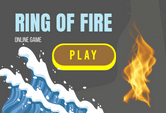Pacific Ring Of Fire Game Quiz Online
This Pacific Ring Of Fire Game Quiz Online is for students in 5th, 6th, 7th, 8th grades. If you know a thing or two about plate tectonics, you probably heard about the Pacific Ring of fire as one of the outcomes of this process. Tectonic plates are coliding under the Pacific ocean leading to volcanic activities over a stretch of about 40,000 km. This phenomenon is leading to continent building in the ocean and that is how the continents we live in were formed. There are a lot of interesting facts about the ring of fire and this game summerizes that most interesting ones through 15 multiple choice questions. This game can be used by students in the classroom to review this topic. The game is free and always online and can be accessed from any device.

The Pacific Ring of Fire and Mineral Deposits
The Pacific Ring of Fire is a region of the Earth that spans about 40,000 kilometers. It sits on the edges of the Pacific Ocean, where the tectonic plates of the Earth meet. These huge pieces of the Earth's outer layer are larger than entire continents and they slide beneath each other. When they slip and pass each other, they create earthquakes. There are also eruptions that occur in the Ring of Fire, although they may not cause earthquakes.
Geology
The Ring of Fire is the result of tectonic activity in the Pacific Ocean. Two tectonic plates, the Aleutian Islands in Alaska and the Andes in South America, run parallel to each other. When these plates collide, they cause earthquakes and volcanic activity. In some cases, these tectonic plates are even pushed under each other! This is called subduction.
Seismic activity is constant in the Ring of Fire, and volcanic activity is widespread. Nearly 75% of the world's active volcanoes are in this region. In fact, this region has caused 90% of the world's earthquakes and volcanoes, including the Tohoku earthquake. These volcanoes and earthquakes are the result of tectonic movements, and geologists are able to interpret the origin of geological events using maps and Google Earth overflights.
Earthquakes are not uncommon in the Ring of Fire: 90% of all earthquakes in the world occur in this area. Seventy-five percent of the world's active volcanoes are located here, and seventy-five percent of the 25 largest eruptions have occurred in this region. These earthquakes often trigger tsunamis, which are often deadly.
Volcanoes
The Pacific Ring of Fire is one of the most seismically active regions on Earth, with most volcanoes located at subduction zones. A continuous chain of volcanic arcs and rifts defines the Ring of Fire, a 40,000-km-long seismic belt that runs around the Pacific Ocean. The Ring of Fire extends from the southern tip of South America, through Eastern Asia and Australia, and then down to the West Pacific. It includes the islands of Japan and Indonesia, and it ends with several dormant and active volcanoes in Antarctica.
The downgoing plate, always an oceanic plate, has collected water-saturated sediments and uppermost mantle that heat up as the downgoing plate is forced into the hotter mantle. This heat causes the water-saturated sediments and uppermost mantle to boil, releasing magma. This subduction process is the primary cause of the frequent earthquakes and volcanoes in the Pacific Ring of Fire.
Deep ocean trench
The movement of tectonic plates is the process that creates mountains and islands and deep ocean trenches. This movement of plates generates enormous energy and causes earthquakes. Some earthquakes are small and harmless, but others are so powerful that they cause significant damage.
A team of international scientists, including a researcher from Texas A&M University, has discovered that the deep ocean trenches of the Pacific Ocean are much younger than previously thought. This finding could change our previous understanding of the depth of ocean trenches. The scientists analyzed cores from the subduction zone south of Japan, which lies about 4,800 feet below the surface of the Pacific Ocean. This study reveals the complex interactions between the two bodies of water, which could help scientists better understand the role of deep ocean trench formation on Earth's climate.
Energy Sources in Pacific Ring of Fire
To find the best minerals for mining, you must first understand the geological features of the Pacific Ring of Fire. The South Pacific is known for its abundance of mineral deposits found in the surrounding areas. The Pacific Ring of Fire contains about 40% of the world's geothermal energy resources. This is primarily due to its location on a tectonically active plate boundary. This region has accumulated an abundance of heat associated with the generation of electricity. Because the area is rich in geothermal resources, 13 GW of power generation facilities have already been installed. These discoveries provide valuable raw materials for mining and are an excellent source of energy for the world economy.
